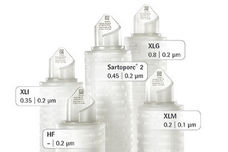Tiny tool can play big role against tuberculosis
A tiny filter could have a big impact around the world in the fight against tuberculosis. Using the traditional microscope-based diagnosis method as a starting point, a University of Florida lung disease specialist and colleagues in Brazil have devised a way to detect more cases of the bacterial infection.
“We’re hopeful that this more sensitive method, which is both simple and inexpensive, will improve diagnosis in patients,” said lead researcher Kevin Fennelly, M.D., M.P.H., an associate professor in the UF College of Medicine’s department of medicine and Southeastern Tuberculosis Center, and the UF Emerging Pathogens Institute.
The new technique, which involves vacuum filtering a sputum sample treated with household bleach and other simple chemicals through a small filter, could dramatically improve TB diagnoses globally, particularly in settings where the disease is common and resources are limited. It is especially useful when the presence of only a small number of bacteria in the test sample makes it hard to detect TB. The researchers are refining the technique in hopes of developing a cost-effective product that can be used globally.
Funded by the World Health Organization and the Núcleo de Doenças Infecciosas infectious disease institute in Brazil, the study appears online and in an upcoming print edition of the Journal of Clinical Microbiology.
“TB is still a tremendously important disease worldwide and control efforts are greatly hindered by lack of simple, inexpensive diagnostics that could be used at the point of care,” said Elizabeth Talbot, M.D., a Dartmouth College infectious diseases and TB diagnostics expert who was not involved in the UF research. “What Dr. Fennelly has done is capitalize on existing infrastructure of microscopy to try to improve performance of that prevalent diagnostic tool.”
The most widely used way to confirm TB infection is to use a microscope to identify and count disease-causing bacteria in sputum smeared onto a glass slide. This so-called direct-smear method also helps health professionals figure out how likely people are to pass on the disease, what treatment decisions should be made, and how well patients are responding to treatment. Although the method has been in continuous use for more than a century, it can be unreliable, catching cases only about half of the time, on average.
Part of the problem is that sometimes sputum samples don’t contain many bacteria, making it hard to detect TB. Concentrating bacteria onto a small area could help improve detection accuracy, and although previous efforts have led to improvements, they tend to require expensive equipment or technical know-how. In some cases, gains were offset by loss of sample or safety concerns. So the quest for a low-cost, simple, effective method led back to the trusty microscope.
In the early 1980s researchers vacuum-filtered sputum samples to trap TB bacteria onto quarter-sized filters that were then viewed under a microscope. But the filters hung over the sides of standard microscope slides, posing a health hazard and preventing proper inspection. So Fennelly and his team decided to try smaller-than-a-dime filters that fit neatly onto microscope slides and that concentrated the bacteria even more.
Among 314 patients in Brazil suspected as having TB, but not yet in treatment, the small-filter method detected 89 percent of cases, compared with 60 percent detection when samples were concentrated by the currently used method of rapid spinning, and 56 percent detection when sputum smears were looked at directly under the microscope. Furthermore, the small-filter method identified almost three-quarters of TB-positive cases that had been incorrectly reported as negative based on the traditional technique.
Other news from the department science
These products might interest you

Sartopore®2 by Sartorius
Effective mycoplasma removal and sterilisation
Lowest filtration costs and maximum safety for your processes

Sartopore® Platinum by Sartorius
Efficient filtration with minimal protein adsorption
Reduces rinsing volume by 95 % and offers 1 m² filtration area per 10"

Get the life science industry in your inbox
From now on, don't miss a thing: Our newsletter for biotechnology, pharma and life sciences brings you up to date every Tuesday and Thursday. The latest industry news, product highlights and innovations - compact and easy to understand in your inbox. Researched by us so you don't have to.



















































